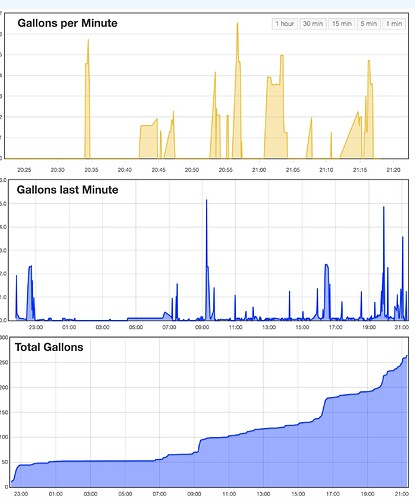So I have added three water meters to our house and have got two of them up and running and dumping the pulse data into emoncms.
I am reporting back to my emonpi once per minute when the water is not flowing and once per gallon while the water is flowing. My emonhub conf is reporting back to emoncms at 5 second intervals of bulk data.
Here is what I would like to do:
- Monitor, (in near real time) water usage. I realize that I am only reporting every 1 gallon, so this is enough of “near real time” for me.
The problem that I am having is that regardless of how much water I am using, my feed shows only 1 gallon per minute. I have verified that the pulses are making it to emoncms as they report correct, but the Rate of Change graph and the realtime graph of the same show a max of 1 gallon per minute when it actually varies between 10 and 30 gallons per minute. I did convert pulses to gallons as the first rule on my feed, not sure if that is causing issues.
-
Track my exact meter reading. I thought this would be easy, simply add my meter reading to the beginning of my feed and I’m done. The problem is that every time I want to make a change to my sketch, the pulses reset themselves and I have to recalculate my total again off the meter. I am SURE I am missing something simple.
-
Track daily and monthly usage. I thought the power to kWh/d or kWh to kWh/d would be the way to go, but each time I add those feeds, they end up turning red with ERROR and not doing anything at all.
My meters are 10 pulses per gallon, so here is what I did:
- X .1 (=gallons instead of pulses)
-
- Current Meter Reading
- Log to Feed
- Rate of Change
I think I have the rate of change working, the graphing sees to go up and down based on water flow so that looks pretty good.
What I need help with is the daily and monthly totals as well as a running meter total regardless of how many time I reprogram my emonTHs!
Thanks


